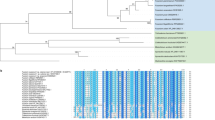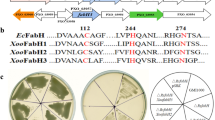Abstract
Plant cell wall acts as a primary barrier for microbial pathogens during infection. A cell wall-degrading enzyme thus may be a crucial virulence factor, as it may aid the pathogen in successful host invasion. Nine genes coding for feruloyl esterases (Fae), likely involved in plant cell wall degradation, have been annotated in the genome of the cereal-blast fungus Magnaporthe oryzae. However, role of any Fae in pathogenicity of M. oryzae remains hitherto under explored. Here, we identified FAE1 gene (MGG_08737) that was significantly upregulated during host penetration and subsequent colonisation stages of infection. Accordingly, while deletion of FAE1 in M. oryzae did not affect the vegetative growth and asexual development, the fae1Δ mutant showed significantly reduced pathogenesis on rice plants, mainly due to impaired host invasion and colonisation. Very few (< 10%) fae1Δ appressoria that formed the primary invasive hyphae failed to elaborate from the first invaded cell to the neighbouring plant cells. Interestingly, exogenously added glucose, as a simple carbon source, or ferulic acid, a product of the Fae activity, significantly supported the invasive growth of the fae1Δ mutant. We show that the Fae1-based feruloyl esterase activity, by targeting the plant cell wall, plays an important role in accumulating ferulic acid and/or sugar molecules, as a likely energy source, to enable host invasion and colonisation by M. oryzae. Given its role in plant cell wall digestion and host colonisation, M. oryzae Fae1 could be a potential candidate for a novel antifungal strategy and a biotechnological application in biofuel production.





source for M. oryzae. Vegetative growth of the WT M. oryzae on basal medium (BM) with or without 0.01% ferulic acid as the sole carbon source. The images were taken at 10 dpi


source enabling successful host invasion and colonisation by the blast fungal pathogen
Similar content being viewed by others
References
Balcerzak M, Harris LJ, Subramaniam R, Ouellet T (2012) The feruloyl esterase gene family of Fusarium graminearum is differentially regulated by aromatic compounds and hosts. Fungal Biol 116:478–488
Black RLB, Dix NJ (1976) Utilization of ferulic acid by microfungi from litter and soil. Transact British Mycol Soc 66:313–317
Bunzel M, Ralph J, Marita JM, Hatfield RD, Steinhart H (2001) Diferulates as structural components in soluble and insoluble cereal dietary fibre. J Sci Fd Agric 81:653–660
Capella-Gutiérrez S, Silla-Martínez JM, Gabaldón T (2009) trimAl: A tool for automated alignment trimming in large-scale phylogenetic analyses. Bioinformatics 25:1972–1973
Cosgrove DJ (2001) Wall structure and wall loosening. A look backwards and forwards. Plant Physiol 125:131–134
Crepin VF, Faulds CB, Connerton IF (2004) Functional recognition of new classes of feruloyl esterases. Appl Microbiol Biotechnol 63:647–652
De Vries RP, Michelsen B, Poulsen CH, Kroon PA, van den Heuvel RHH et al (1997) The FAEA genes from Aspergillus niger and Aspergillus tubingensis encode ferulic acid esterases involved in degradation of complex cell wall polysaccharides. Appl Environ Microbiol 63:4638–4644
De Vries RP, Vankuyk PA, Kester HCM, Visser J (2002) The Aspergillus niger FAEB gene encodes a second feruloyl esterase involved in pectin and xylan degradation and is specifically induced in the presence of aromatic compounds. Biochem J 363:377–386
Dean RA, Talbot NJ, Farman ML, Mitchell TK, Orbach MJ et al (2005) The genome sequence of the rice blast fungus Magnaporthe grisea. Nature 434:980–986
Dellaporta SL, Wood J, Hicks JB (1983) A plant DNA minipreparation: Version II. Plant Mol Biol Rep 1:19–21
Dilokpimol A, Makela MR, Anguilar-Pontes MV, Benoit-Gelber I, Hidden KS et al (2016) Diversity of fungal feruloyl esterases: updated phylogenetic classification, properties, and industrial applications. Biotechnol Biofuels 9:231
Ebbole DJ (2007) Magnaporthe as a model for understanding host–pathogen interactions. Annu Rev Phytopathol 45:437–456
Eddy SR (2011) Accelerated profile HMM searches. PLoS Comput. Biol. 7:e1002195
Faulds CB, Williamson G (1994) Purification and characterization of a ferulic acid esterase (FAE-III) from Aspergillus niger: specificity for the phenolic moiety and binding to micro-crystalline cellulose. Microbiology 140:779–787
Faulds CB, Williamson G (1995) Release of ferulic acid from wheat bran by a ferulic acid esterase (FAE-III) from Aspergillus niger. Appl Microbiol Biotechnol 43:1082–1087
Fernandez J, Wilson RA (2014) Cells in cells: morphogenetic and metabolic strategies conditioning rice infection by the blast fungus Magnaporthe oryzae. Protoplasma 251:37–47
Gietz RD, Woods RA (2002) Transformation of yeast by lithium acetate/single-stranded carrier DNA/polyethylene glycol method. Methods Enzymol 350:87–96
Harris PJ, Hartley RD (1977) Detection of bound ferulic acid in cell walls of the Gramineae by ultraviolet fluorescence microscopy. Nature 259:508–510
Hermoso JA, Aparicio JS, Molina R, Juge N, Gonzalez R et al (2004) The crystal structure of Feruloyl esterase A from Aspergillus niger suggests evolutive functional convergence in feruloyl esterase family. J Mol Biol 338:495–506
Howard RJ, Ferrari MA, Roach DH, Money NP (1991) Penetration of hard substrates by a fungus employing enormous turgor pressure. Proc Natl Acad Sci USA 88:11281–11284
Jeon J, Lee GW, Kim KT, Park SY, Kim S et al (2020) Transcriptome profiling of the rice blast fungus Magnaporthe oryzae and its host Oryza sativa during infection. Mol Plant Microbe Interact 33:141–144
Kachroo P, Leong SA, Chattoo BB (1994) Pot2, an inverted repeat transposon from the rice blast fungus Magnaporthe grisea. Mol Gen Genet 245:339–348
Kachroo P, Lee KH, Schwerdel C, Bailey JE, Chattoo BB (1997) Analysis of host-induced response in the rice blast fungus Magnaporthe grisea using two-dimensional polyacrylamide gel electrophoresis. Electrophoresis 18:163–169
Kubicek CP, Starr TL, Glass NL (2014) Plant cell wall-degrading enzymes and their secretion in plant-pathogenic fungi. Annu Rev Phytopathol 52:427–451
Lee S, Kelley BS, Damasceno CMB et al (2006) A functional screen to characterize the secretomes of eukaryotic pathogens and their hosts in planta. Mol Plant Microbe Interact 19:1368–1377
Letunic I, Bork P (2021) Interactive Tree Of Life (iTOL) v5: an online tool for phylogenetic tree display and annotation. Nucleic Acids Res 49(W1):W293–W296
Livak KJ, Schmittgen TD (2001) Analysis of relative gene expression data using real-time quantitative PCR and the 2-ΔΔCT method. Methods 25:402–408
Marchler-Bauer A, Derbyshire MK, Gonzales NR, Lu S, Chitsaz F et al (2015) CDD: NCBI’s conserved domain database. Nucleic Acids Res. 43(Database issue):D222–D226
Mastihuba V, Kremnicky L, Mastihubova M, Willett JL, Cote GL (2002) A spectrophotometric assay for feruloyl esterases. Anal Biochem 309:96–101
Minh BQ, Schmidt HA, Chernomor O, Schrempf D, Woodhams MD, von Haeseler A et al (2020) IQ-TREE 2: New models and efficient methods for phylogenetic inference in the genomic era. Mol Biol Evol 37:1530–1534
Nguyen QB, Itoh K, Vu VB, Tosa Y, Nakayashiki H (2011) Simultaneous silencing of endo-β-1,4 xylanase genes reveals their roles in the virulence of Magnaporthe oryzae. Mol Microbiol 81:1008–1019
Patkar RN, Suresh A, Naqvi NI (2010) MoTea4-mediated polarized growth is essential for proper asexual development and pathogenesis in Magnaporthe oryzae. Eukaryot Cell 9:1029–1038
Patkar RN, Ramos-Pamplona M, Gupta AP, Fan Y, Naqvi NI (2012) Mitochondrial β-oxidation regulates organellar integrity and is necessary for conidial germination and invasive growth in Magnaporthe oryzae. Mol Microbiol 86:1345–1363
Patkar RN, Benke PI, Qu Z, Chen Y, Yang F et al (2015) A fungal monooxygenase-derived jasmonate attenuates host innate immunity. Nat Chem Biol 11:733–740
Petersen TN, Brunak S, Heijne G, Nielsen H (2011) SignalP 4.0: discriminating signal peptides from transmembrane regions. Nat Methods 8:785–786
Prakash C, Manjrekar J, Chattoo BB (2016) Skp1, a component of E3 ubiquitin ligase, is necessary for growth, sporulation, development and pathogenicity in rice blast fungus (Magnaporthe oryzae). Mol Plant Pathol 17:903–919
Sievers F, Higgins DG (2018) Clustal Omega for making accurate alignments of many protein sequences. Protein Sci 27:135–145
Sievers F, Wilm A, Dineen D, Gibson TJ, Karplus K et al (2011) Fast, scalable generation of high-quality protein multiple sequence alignments using Clustal Omega. Mol Syst Biol 7:539
Skamnioti P, Gurr SJ (2007) Magnaporthe grisea Cutinase2 mediates appressorium differentiation and host penetration and is required for full virulence. Plant Cell 19:2674–2689
Skamnioti P, Gurr SJ (2008) Against the grain: safeguarding rice from rice blast disease. Trends Biotechnol 27:141–150
Soundararajan S, Jedd G, Li X, Ramos-Pamploña M, Chua NH et al (2004) Woronin body function in Magnaporthe grisea is essential for efficient pathogenesis and for survival during nitrogen starvation stress. Plant Cell 16:1564–1574
Tamura K, Stecher G, Kumar S (2021) MEGA11: Molecular Evolutionary Genetics Analysis version 11. Mol Biol Evol 38:3022–3027
Valent B, Khang CH (2010) Recent advances in rice blast effector research. Curr Opin Plant Biol 13:434–441
Vu BV, Itoh K, Nguyen QB, Tosa Y, Nakayashiki H (2012) Cellulases belonging to glycoside hydrolase families 6 and 7 contribute to the virulence of Magnaporthe oryzae. Mol Plant Microbe Interact 25:1135–1141
Wang ZY, Soanes DM, Kershaw MJ, Talbot NJ (2007) Functional analysis of lipid metabolism in Magnaporthe grisea reveals a requirement for peroxisomal fatty acid beta-oxidation during appressorium-mediated plant infection. Mol Plant Microbe Interact 20:475–491
Xu M, Gao X, Chen J, Yin Z, Feng H, Huang L (2017) The feruloyl esterase genes are required for full pathogenicity of the apple tree canker pathogen Valsa mali. Mol Plant Pathol 19:1353–1363
Yang F, Naqvi N (2014) Sulfonylurea resistance reconstitution as a novel strategy for ILV2-specific integration in Magnaporthe oryzae. Fungal Genet Biol 68:71–76
Yang C, Yu Y, Huang J, Meng F, Pang J et al (2019) Binding of the Magnaporthe oryzae chitinase MoChia1 by a rice tetratricopeptide repeat protein allows free chitin to trigger immune responses. Plant Cell 31:172–188
Yu JH, Hamari Z, Han KH, Seo JA, Reyes-Domínguez Y et al (2004) Double-joint PCR: a PCR-based molecular tool for gene manipulations in filamentous fungi. Fungal Genet Biol 41:973–981
Zheng X, Zhou J, Lin C, Lin X, Lan L et al (2009) Secretion property and gene expression pattern of a putative feruloyl esterase in Magnaporthe grisea. In: Xiaofan W, Valent B (eds) Advances in genetics, genomics and control of rice blast disease, 1st edn. Springer, Netherlands, pp 41–50
Acknowledgements
We acknowledge late Prof. Bharat B. Chattoo for his guidance and providing sophisticated laboratory facility at the Bharat Chattoo Genome Research Centre (BCGRC). We also fondly remember late Dr. Johannes Manjrekar for the useful scientific discussions during the course of this work. We thank Naweed Naqvi (Temasek Lifesciences Laboratory, Singapore) for providing backbone vector pFGL1010. AT was supported by UGC-BSR-RFSMS (F.7-128/2007-BSR, dtd-02.09.2014), University Grants Commission, Government of India (GoI); and KM acknowledges the intramural University Research Scholarship from The M. S. University of Baroda. This work was supported by the Ramalingaswami Fellowship (BT/RLF/Re-entry/32/2014), DBT, GoI, awarded to RP. We also acknowledge the funding support (EMR/2017/005303) from SERB, GoI. We thank the BCGRC group at MSU for useful discussions.
Author information
Authors and Affiliations
Contributions
Conceptualization: AT and RP; methodology: AT and RP; validation: AT and KM; formal analysis: AT; investigation: AT and KM; resources: RP; writing—original draft: AT and KM; writing—review and editing: RP; supervision: RP; project administration: RP; funding acquisition: RP.
Corresponding author
Ethics declarations
Competing interests
Authors declare that there are no competing interests involved in this work.
Ethics approval
Not applicable.
Consent to participate
Not applicable.
Consent for publication
Not applicable.
Additional information
Publisher's Note
Springer Nature remains neutral with regard to jurisdictional claims in published maps and institutional affiliations.
Supplementary Information
Below is the link to the electronic supplementary material.
Rights and permissions
About this article
Cite this article
Thaker, A., Mehta, K. & Patkar, R. Feruloyl esterase Fae1 is required specifically for host colonisation by the rice-blast fungus Magnaporthe oryzae. Curr Genet 68, 97–113 (2022). https://doi.org/10.1007/s00294-021-01213-z
Received:
Revised:
Accepted:
Published:
Issue Date:
DOI: https://doi.org/10.1007/s00294-021-01213-z




